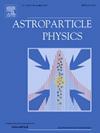爱因斯坦-麦克斯韦膨胀-轴子引力中克尔-森黑洞的薄吸积盘和阴影
IF 2.9
3区 物理与天体物理
Q1 ASTRONOMY & ASTROPHYSICS
引用次数: 0
摘要
我们研究了爱因斯坦-麦克斯韦膨胀-轴子引力中克尔-森黑洞的薄盘和阴影。结果表明,随着膨胀参数r2的增大,圆盘的能量通量、辐射温度、光谱光度和辐射效率均增大。通过将膨胀参数范围缩小到0≤r2M≤0.4,我们发现在高频区域,Kerr - sen黑洞比Kerr黑洞表现出更高的能量输出。我们还研究了均匀等离子体环境下Kerr-Sen黑洞的阴影。在倾角、膨胀和自旋参数固定的情况下,随着均匀等离子体参数k的增大,阴影增大。相反,当k和a固定时,r2的增加导致阴影的减少。最后,我们用M87*和Sgr A*的观测数据来约束模型参数。本文章由计算机程序翻译,如有差异,请以英文原文为准。
Thin accretion disk and shadow of Kerr–Sen black hole in Einstein–Maxwell-dilaton–axion gravity
We investigate the thin disk and shadow of Kerr–Sen black hole in Einstein–Maxwell-dilaton–axion gravity. The results reveal that as the dilaton parameter increase, the energy flux, the radiation temperature, the spectra luminosity, and the radiative efficiency of the disk all increase. By narrowing down the dilaton parameter range to , we discover that in the high-frequency region, the Kerr–Sen black hole demonstrates higher energy output compared to the Kerr black hole. We also investigated the shadow of Kerr–Sen black hole in a uniform plasma environment. For fixed inclination angle, dilaton, and spin parameters, the shadow increases as the homogeneous plasma parameter increases. Conversely, when and are fixed, an increase in leads to a decrease in the shadow. Finally, we constrain the model parameters with observational data from M87* and Sgr A*.
求助全文
通过发布文献求助,成功后即可免费获取论文全文。
去求助
来源期刊

Astroparticle Physics
地学天文-天文与天体物理
CiteScore
8.00
自引率
2.90%
发文量
41
审稿时长
79 days
期刊介绍:
Astroparticle Physics publishes experimental and theoretical research papers in the interacting fields of Cosmic Ray Physics, Astronomy and Astrophysics, Cosmology and Particle Physics focusing on new developments in the following areas: High-energy cosmic-ray physics and astrophysics; Particle cosmology; Particle astrophysics; Related astrophysics: supernova, AGN, cosmic abundances, dark matter etc.; Gravitational waves; High-energy, VHE and UHE gamma-ray astronomy; High- and low-energy neutrino astronomy; Instrumentation and detector developments related to the above-mentioned fields.
 求助内容:
求助内容: 应助结果提醒方式:
应助结果提醒方式:


